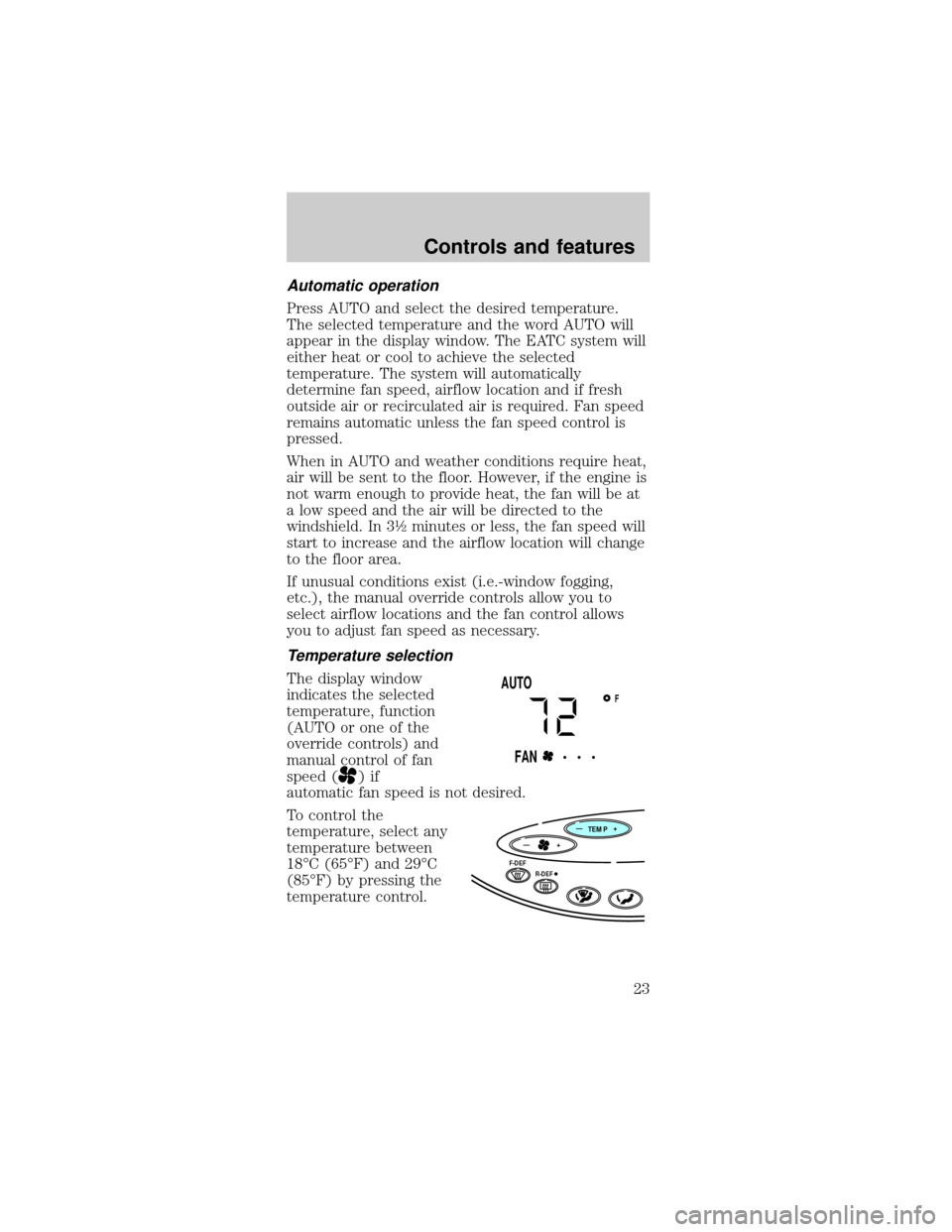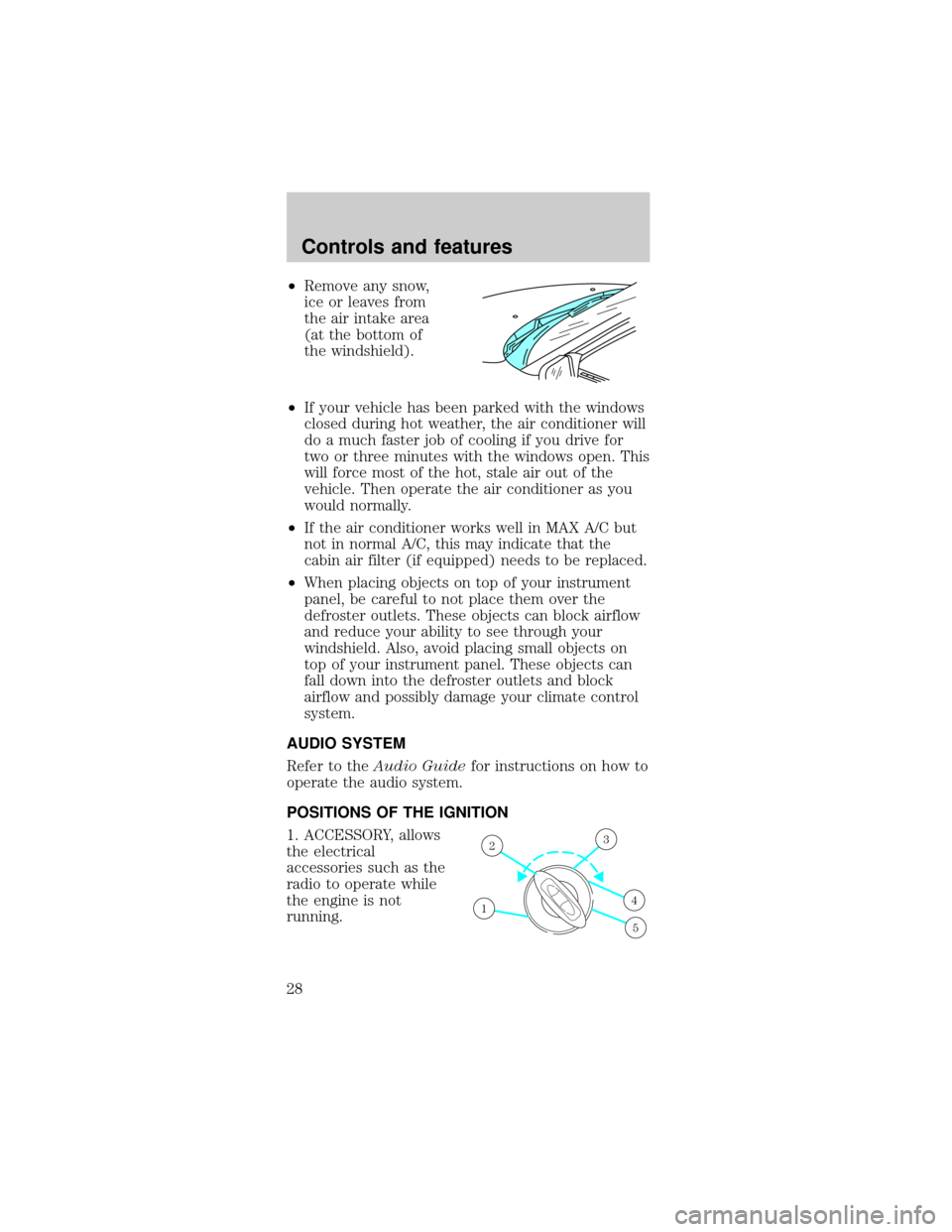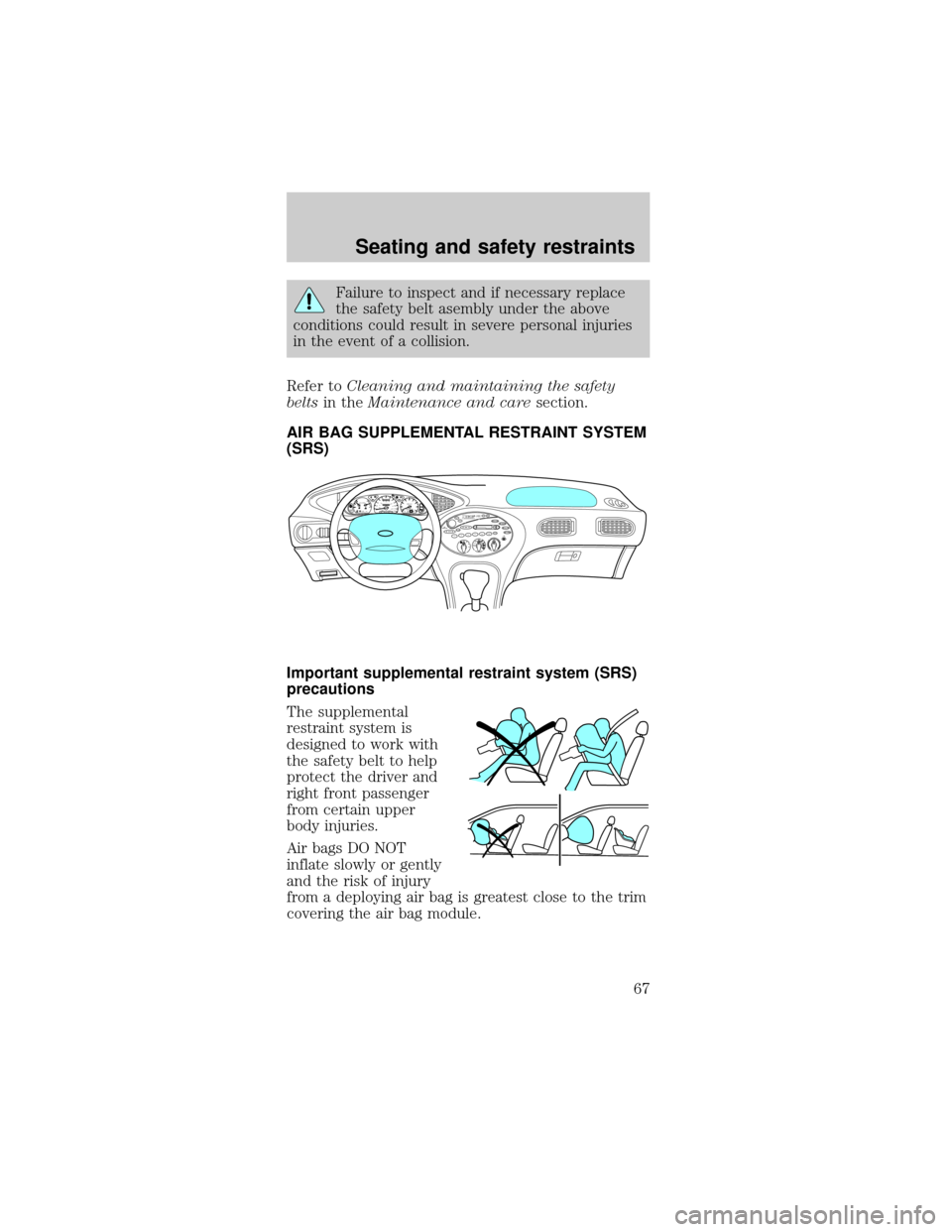Page 13 of 192
Speedometer
Indicates the current vehicle speed.
²Standard instrument
cluster
²Optional instrument
cluster
Tachometer
Indicates the engine speed in revolutions per
minute.
²Standard instrument
cluster
²SHO instrument
cluster (if equipped)
Driving with your tachometer pointer in the red
zone may damage the engine.
1020304050 60
70
80
90
100
110
0
0 20406080100
120
140
160
180P R N D D 1MPH km/h
00
000
00000
102030405060
70
80
90
100
1202060100
140
180
P R N D 2 1MPH km/h
00
000
00000
110
RPMx1000
0 1234
5
6
7UNLEADED FUEL ONLY
RPMx1000
PREMIUM UNLEADED
FUEL RECOMMENDED0 1234
5
6
78
Instrumentation
13
Page 14 of 192
Engine coolant temperature gauge
Indicates the
temperature of the
engine coolant. At
normal operating
temperature, the
needle remains within
the normal area (the
area between the ªHº
and ªCº). If it enters the red section, the engine is
overheating. Stop the vehicle as soon as safely
possible, switch off the engine immediately and let
the engine cool. Refer toEngine coolantin the
Maintenance and carechapter.
Never remove the coolant reservoir cap
while the engine is running or hot.
This gauge indicates the temperature of the engine
coolant, not the coolant level. If the coolant is not at
its proper level the gauge indication will not be
accurate.
Odometer
Registers the total
kilometers (miles) of
the vehicle.
C H
102030405060
70
80
90
100
1202060100
140
180
P R N D 2 1MPH km/h
00
000
00000
110
Instrumentation
14
Page 16 of 192
HEADLAMP CONTROL
Rotate the headlamp
control to the first
position to turn on the
parking lamps only.
Rotate to the second
position to also turn on
the headlamps.
Daytime running lamps (DRL) (if equipped)
Turns the highbeam headlamps on with a reduced
output. To activate:
²the engine must be running and
²the headlamp control is in the OFF or Parking
lamps position.
The Daytime Running Light (DRL) system
will not illuminate the tail lamps and parking
lamps. Turn on your headlamps at dusk. Failure to
do so may result in a collision.
High beams
Push forward to
activate.
PPANEL
DIMAUTO
LAMP
Controls and features
16
Page 23 of 192

Automatic operation
Press AUTO and select the desired temperature.
The selected temperature and the word AUTO will
appear in the display window. The EATC system will
either heat or cool to achieve the selected
temperature. The system will automatically
determine fan speed, airflow location and if fresh
outside air or recirculated air is required. Fan speed
remains automatic unless the fan speed control is
pressed.
When in AUTO and weather conditions require heat,
air will be sent to the floor. However, if the engine is
not warm enough to provide heat, the fan will be at
a low speed and the air will be directed to the
windshield. In 3ó minutes or less, the fan speed will
start to increase and the airflow location will change
to the floor area.
If unusual conditions exist (i.e.-window fogging,
etc.), the manual override controls allow you to
select airflow locations and the fan control allows
you to adjust fan speed as necessary.
Temperature selection
The display window
indicates the selected
temperature, function
(AUTO or one of the
override controls) and
manual control of fan
speed (
)if
automatic fan speed is not desired.
To control the
temperature, select any
temperature between
18ÉC (65ÉF) and 29ÉC
(85ÉF) by pressing the
temperature control.
FAUTO
FAN• • •
TEMP
—+
F-DEF
R-DEF
—+
Controls and features
23
Page 28 of 192

²Remove any snow,
ice or leaves from
the air intake area
(at the bottom of
the windshield).
²If your vehicle has been parked with the windows
closed during hot weather, the air conditioner will
do a much faster job of cooling if you drive for
two or three minutes with the windows open. This
will force most of the hot, stale air out of the
vehicle. Then operate the air conditioner as you
would normally.
²If the air conditioner works well in MAX A/C but
not in normal A/C, this may indicate that the
cabin air filter (if equipped) needs to be replaced.
²When placing objects on top of your instrument
panel, be careful to not place them over the
defroster outlets. These objects can block airflow
and reduce your ability to see through your
windshield. Also, avoid placing small objects on
top of your instrument panel. These objects can
fall down into the defroster outlets and block
airflow and possibly damage your climate control
system.
AUDIO SYSTEM
Refer to theAudio Guidefor instructions on how to
operate the audio system.
POSITIONS OF THE IGNITION
1. ACCESSORY, allows
the electrical
accessories such as the
radio to operate while
the engine is not
running.
1
23
4
5
Controls and features
28
Page 29 of 192
2. LOCK, locks the steering wheel, automatic
transmission gearshift lever and allows key removal.
3. OFF, shuts off the engine and all accessories
without locking the steering wheel.
4. ON, all electrical circuits operational. Warning
lights illuminated. Key position when driving.
5. START, cranks the engine. Release the key as
soon as the engine starts.
SPEED CONTROL (IF EQUIPPED)
To turn speed control on
²Press ON.
Vehicle speed cannot
be controlled until the
vehicle is traveling at
or above 48 km/h (30
mph).
Do not use the speed control in heavy traffic
or on roads that are winding, slippery, or
unpaved.
Do not shift the gearshift lever into N
(Neutral) with the speed control on.
OFF ON
Controls and features
29
Page 53 of 192

You must complete steps 1 through 5 within 30
seconds or the procedure will have to be repeated. If
the procedure needs to be repeated, you must wait
30 seconds.
1. Turn the ignition key from OFF to RUN/ACC.
2. Press the power door UNLOCK control three
times.
3. Turn the ignition key from RUN/ACC to OFF.
4. Press the power door UNLOCK control three
times.
5. Turn the ignition key from OFF to RUN/ACC. A
horn chirp indicates the enable/disable feature is
entered.
6. Press the power door UNLOCK control one time.
7. Press the power door LOCK control to toggle the
Autolock/Relock state. You will receive a horn chirp
followed by either a long honk, autolock/relock is
enabled, or no honk, autolock/relock is disabled.
8. Turn ignition to OFF.
If autolock/relock has been changed, the horn will
chirp to confirm procedure is complete.
SECURILOCKYANTI-THEFT SYSTEM
The SecuriLockyanti-theft system provides an
advanced level of vehicle theft protection. Your
vehicle's engine can only be started with the two
special SecuriLockyelectronically coded keys
provided with your vehicle. Each time you start your
vehicle, the SecuriLockykey is read by the
SecuriLockyanti-theft system. If the SecuriLocky
key identification code matches the code stored in
the SecuriLockyanti-theft system, the vehicle's
engine is allowed to start. If the SecuriLockykey
identification code does not match the code stored
in the system or if a SecuriLockykey is not
detected (vehicle theft situation), the vehicle's
engine will not operate.
Controls and features
53
Page 67 of 192

Failure to inspect and if necessary replace
the safety belt asembly under the above
conditions could result in severe personal injuries
in the event of a collision.
Refer toCleaning and maintaining the safety
beltsin theMaintenance and caresection.
AIR BAG SUPPLEMENTAL RESTRAINT SYSTEM
(SRS)
Important supplemental restraint system (SRS)
precautions
The supplemental
restraint system is
designed to work with
the safety belt to help
protect the driver and
right front passenger
from certain upper
body injuries.
Air bags DO NOT
inflate slowly or gently
and the risk of injury
from a deploying air bag is greatest close to the trim
covering the air bag module.
BASSTREBBALFADEREWFFEJECT1234
56wTAPE SIDETAPE
R-DEFTUNESEEKSCAN AM
FMMH
LO
HIOFF
A/C
MAX
A/CVENTVOL
PUSH-ONwSTFM 12
AMCBLRFEFC HFUEL DOOR>SERVICE
ENGINE
SOONLOW
COOLANTTHEFT102030405060
70
80
90
100
1202060100
140
180P R N D 2 1MPH km/h0000000000P!
BRAKE+ –110CRUISERPMx1000ABSO/D
OFFREAR
LAMP
OUTPREMIUM UNLEADED
FUEL RECOMMENDED0 1234
5
6
78
Seating and safety restraints
67